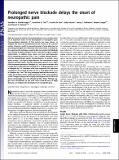Prolonged nerve blockade delays the onset of neuropathic pain
Author(s)
Shankarappa, Sahadev A.; Tsui, Jonathan H.; Kim, Kristine N.; Reznor, Gally; Dohlman, Jenny C.; Langer, Robert S; Kohane, Daniel S; ... Show more Show less
DownloadShankarappa-2012-Prolonged nerve blockade delays the onset of neuropathic pain.pdf (943.0Kb)
PUBLISHER_POLICY
Publisher Policy
Article is made available in accordance with the publisher's policy and may be subject to US copyright law. Please refer to the publisher's site for terms of use.
Terms of use
Metadata
Show full item recordAbstract
Aberrant neuronal activity in injured peripheral nerves is believed to be an important factor in the development of neuropathic pain. Pharmacological blockade of that activity has been shown to mitigate the onset of associated molecular events in the nervous system. However, results in preventing onset of pain behaviors by providing prolonged nerve blockade have been mixed. Furthermore, the experimental techniques used to date to provide that blockade were limited in clinical potential in that they would require surgical implantation. To address these issues, we have used liposomes (SDLs) containing saxitoxin (STX), a site 1 sodium channel blocker, and the glucocorticoid agonist dexamethasone to provide nerve blocks lasting ∼1 wk from a single injection. This formulation is easily injected percutaneously. Animals undergoing spared nerve injury (SNI) developed mechanical allodynia in 1 wk; nerve blockade with a single dose of SDLs (duration of block 6.9 ± 1.2 d) delayed the onset of allodynia by 2 d. Treatment with three sequential SDL injections resulting in a nerve block duration of 18.1 ± 3.4 d delayed the onset of allodynia by 1 mo. This very prolonged blockade decreased activation of astrocytes in the lumbar dorsal horn of the spinal cord due to SNI. Changes in expression of injury-related genes due to SNI in the dorsal root ganglia were not affected by SDLs. These findings suggest that formulations of this kind, which could be easy to apply clinically, can mitigate the development of neuropathic pain.
Date issued
2012-10Department
Harvard University--MIT Division of Health Sciences and Technology; Koch Institute for Integrative Cancer Research at MITJournal
Proceedings of the National Academy of Sciences of the United States of America
Publisher
National Academy of Sciences (U.S.)
Citation
Shankarappa, S. A. et al. “Prolonged Nerve Blockade Delays the Onset of Neuropathic Pain.” Proceedings of the National Academy of Sciences 109.43 (2012): 17555–17560. CrossRef. Web.
Version: Final published version
ISSN
0027-8424
1091-6490